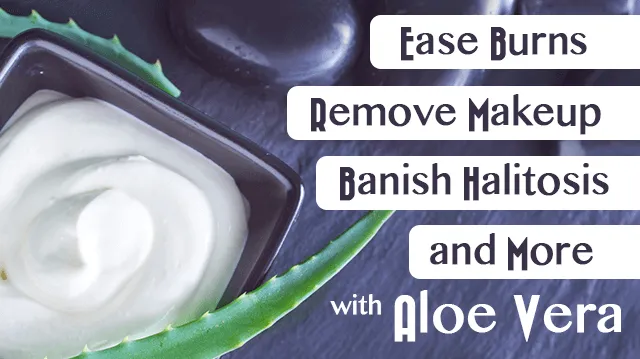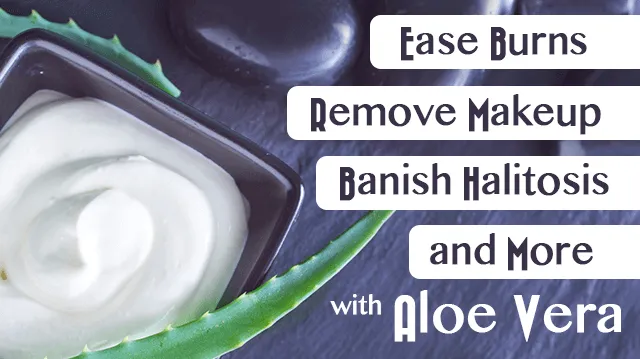
- Share on Facebook49
- Share on Pinterest
- Share on Twitter
The health benefits of aloe vera have been celebrated for thousands of years. Many historians and botanists believe that this plant, which flourishes in desert and tropical climates, originally came from arid parts of Africa. It has been mentioned in the texts of ancient Egyptians, Greeks, Persians and numerous other cultures. Today, aloe vera can be found in warm climates across the United States and in many regions of the world.
Aloe vera, also sometimes known as aloe barbadensis, is a member of the Liliaceae (lily) family, of which onions and garlic are also members. While its medicinal properties have been touted in many texts, one major example is the writing of Dioscorides, the Greek herbalist who traveled with the armies of the Roman empire. He wrote that aloe vera could help stop bleeding in wounds, soothed mouth irritation, aided in “cleansing the stomach,” induced sleep, and helped heal bruises, boils and hemorrhoids, among many other uses.
The aloe vera plant consists of spiny leaves that can reach up to two feet in length. As they mature, the plants develop a stalk that emerges from the center cluster of the leaves. This stalk produces small yellow flowers. The leaves are covered in spots when they are immature, and as they grow, they turn to a more solid, light green color. It is the inside of the leaves that is used medicinally; cut them open and you will find a jelly-like substance that consists of 99 percent water.
There are two different substances within the aloe leaf; both are therapeutic, but they are each suited to different purposes. The bundle sheath cells contain a bitter yellow juice called exudate, which is used as a mild laxative. The inner leaf is made up of parenchymatous cells, which contain a clear gel with an interesting, slightly sweet flavor. This clear gel is valued as a remedy for many conditions.
Aloe gel’s healing properties are attributed in part to its vitamin and mineral content, which includes vitamin A, vitamin C, vitamin E, multiple B vitamins, calcium, magnesium, iron, zinc, selenium, chromium, iron, manganese and potassium. Special carbohydrate polymers called glucomannans and pectic acid also contribute to its medicinal properties.
In fact, there are over 200 healing compounds found in aloe vera gel. This includes many beneficial fatty acids, and the eight amino acids that are “essential” — meaning they cannot be made inside the human body and must be consumed from external sources.
Nutritional profile
The gooey sap of the aloe vera plant is filled with
- Calcium
- Choline
- Chromium
- Copper
- Folic acid
- Germanium
- Iron
- Magnesium
- Manganese
- Potassium
- Protein
- Selenium
- Vitamin A
- Vitamins B1, B2, B3, B6 and B12
- Vitamin C
- Vitamin E
- Zinc
Here are just some of the many therapeutic uses for this amazing plant:
Immunity: The polyphenols contained within the gel can help stimulate the production of immune cells called macrophages, and kill bacteria and yeast to prevent infections. Aloe vera is considered an adaptogen, which means that it provides non-specific support to the immune system to fight the effects of stress and environmental toxins.
Natural multivitamin: Since aloe leaves contain so many vitamins and minerals, adding it to your daily nutritional regimen is a great way to boost consumption from a whole-food source. Try adding two tablespoons of aloe juice to a smoothie, or a morning glass of lemon water.
Diabetes & obesity: Aloe gel has been traditionally used as a remedy for diabetes, and modern studies have tentatively supported its ability to moderate insulin sensitivity and improve the body’s natural ability to manage blood sugar.
Cholesterol levels have also been shown to improve with aloe vera supplementation. This effect is due to the plant sterols which lower fat in the blood.
Cuts: Apply aloe vera gel onto a cleaned wound to help it heal. Its antibacterial properties, vitamins and minerals clean the wound and prevent infection too!
Rashes: If you have a heat rash, rosacea, eczema or psoriasis, dab some aloe vera gel onto the affected area to ease flare-ups. It doesn’t only heal discoloration from skin disorders, it can also work against rashes caused by allergic reactions.
Stubborn makeup: If your makeup doesn’t want to leave your face, smear on some aloe vera to get rid of those raccoon eyes.
Skin problems: You are probably familiar with aloe vera as a treatment for sunburn. This is one of the most studied properties of the plant. Research indicates that treating first- and second-degree burns with aloe gel can reduce healing time by up to nine days.
The refreshing gel is also an effective treatment for acne, and can be used to cleanse dirt, impurities and makeup. It is a natural analgesic (pain-reliever), astringent and also relieves itching. This makes it a great treatment for bug bites as well.
Moreover, research shows that aloe might have anti-aging benefits for skin. In a study conducted on a group of women over the age of 45, a 90-day treatment with aloe vera was found to improve elasticity of the skin by boosting collagen production.
Another study showed that the gel was able to reduce redness and dryness of the skin to improve the complexion. Finally, informal evidence suggests that the anti-inflammatory and nourishing abilities of aloe gel may help conditions like psoriasis and dermatitis.
Shaving cream: Instead of buying shaving creams that contain harsh chemicals, choose aloe vera. Aloe vera is ideal for shaving because it moisturizes the skin. Its antibacterial action can also help heal razor cuts.
Candida: Not only does aloe vera help with external inflammation, but it can actually help reduce inflammation at its source: the gut. Candida is a type of yeast that can spread inflammation throughout your body. Go straight to the source and drink some aloe vera juice. Its antifungal properties go to work immediately to help kill off bad bacteria.
Digestive disorders: As mentioned above, the sticky yellow substance found just under the skin of aloe vera leaves is a traditional remedy for constipation. This is thanks to a compound called aloin, or barbaloin. The balancing and cleansing effects of aloe vera also help keep gut bacteria in check and prevent overgrowth.
Anecdotal evidence also supports the use of aloe gel to soothe digestive conditions such as irritable bowel syndrome. Although scientific studies have not been able to confirm these benefits, very few negative side effects have been associated with aloe consumption in the short to medium term (besides the laxative effect if the exudate is consumed). Therefore, experimenting with aloe vera gel supplementation would appear to be relatively safe.
Pain: Aloe vera’s anti-inflammatory properties make it an excellent natural pain killer. It works to alleviate many conditions ranging from headaches to arthritis and rheumatism.
Halitosis: Many people suffer with bad breath from time to time. As embarrassing as it may be, this can be easily remedied by swishing around aloe vera juice in your mouth. Aloe vera works to fight bad breath by killing the source of bacteria.
Untidy eyebrows: Instead of investing in expensive products, apply some aloe vera gel using a Q-tip instead. The aloe vera will help maintain the shape of your eyebrows and keep those stray hairs in check.
Hand sanitizer: Make your own hand sanitizer by mixing equal parts of rubbing alcohol and aloe vera gel in a container. The rubbing alcohol will kill germs, while the aloe vera moisturizes and also kills bacteria.
Tissue damage: Aloe vera can help protect your skin against the effects of winter weather. Simply rub any exposed skin with aloe vera gel.
Weak gums and teeth: It turns out that aloe vera is not only great for preventing bad breath, but it can actually improve the enamel of your teeth and strengthen your gums.
Congestion: Aloe vera can help reduce congestion and inflammation due to allergies, the flu and the common cold. The vitamins, minerals, enzymes and amino acids in aloe vera juice all contribute to improving the immune system. The juice’s anti-inflammatory properties can also help relieve nasal congestion.
Infections: Due to its antibacterial and anti-inflammatory properties, aloe vera can help heal eye infections, yeast infections, urinary tract infections and fungal infections.
Heart disease: Drinking aloe vera juice can actually help to reduce triglycerides and lower your cholesterol. It can also protect the body from oxidative stress and boost the oxygenation of your blood.
Physical fatigue: Aloe vera contains electrolytes, which can keep your body hydrated and energized, especially after a workout. If taken beforehand, it can also encourage physical stamina and boost cardiovascular performance during a workout. Aloe vera juice provides the body with the vitamins, minerals, enzymes and glyconutrients that it needs for a speedy recovery from any physical exertion, or from an injury.
Cancer: Aloe vera has been shown to actually reduce the growth of cancer tumors, especially in colon cancer patients.
The best aloe vera
 In their study, the “Evaluation of the Nutritional and Metabolic Effects of Aloe Vera,” authors Meika Foster, Duncan Hunger and Samir Samman of the University of Otago, New Zealand, explain that when aloe vera is processed, the whole leaf is first pulverized to produce the juice, and then undergoes processes of filtration and stabilization until the desired extract potency is reached.
In their study, the “Evaluation of the Nutritional and Metabolic Effects of Aloe Vera,” authors Meika Foster, Duncan Hunger and Samir Samman of the University of Otago, New Zealand, explain that when aloe vera is processed, the whole leaf is first pulverized to produce the juice, and then undergoes processes of filtration and stabilization until the desired extract potency is reached.
The authors write, “This method provides ease of processing and higher efficiency in the recovery of the solids, but it can result in a product that contains little or no active ingredients.” They also explain that heating aloe vera, as often occurs during processing, changes its molecular structure.
Commercial aloe vera gels also often include fillers such as maltodextrin (a corn sugar that likely comes from GMO corn), glycerin, glucose and malic acid, and sometimes an array of other chemicals that you probably do not want seeping into your skin.
Luckily, if you have ample sunlight in your home, growing your own aloe vera is easy. Use a wide pot with well-draining soil. Your aloe vera plant should be watered generously, but allowed to dry to an inch or two deep between waterings.
Note:
• Due to its potency, only drink fresh aloe vera juice when needed. Too much can deplete the body’s stores of potassium and other electrolytes.
• It may also interact with certain medications, and should not be used by pregnant or menstruating women, or those with certain liver and gall bladder conditions.
• Because of these precautions, it is highly recommended that you talk to a natural health professional before taking aloe vera internally. A health practitioner will determine if aloe vera supplementation is right for you, the appropriate dosage for your body, and how long to keep taking it.
Once you have the green light, the fresh juice can be taken on its own from a shot glass, or blended into smoothies, to name a couple of options.
— Susan Patterson
Susan is the Content Director at The Alternative Daily, a Certified Health Coach, Certified Metabolic Typing Advisor and Master Gardener. With an extensive knowledge of whole foods and wellness, Susan enjoys educating others on how to live healthy and sustainable lives. She presently lives off grid in the middle of the New Mexican high desert with her three children and numerous animals.
Sources:
http://health.howstuffworks.com/wellness/natural-medicine/herbal-remedies/amazing-aloe-vera.htm
http://www.sciencedirect.com/science/article/pii/S0378874199000859
http://www.sciencedirect.com/science/article/pii/S0378874196014766
http://www.sciencedirect.com/science/article/pii/0378874186900851
http://www.sciencedirect.com/science/article/pii/S019096228870095X
http://bjgp.org/content/bjgp/49/447/823.full.pdf
http://europepmc.org/abstract/med/8169808
http://www.herbwisdom.com/herb-aloe-vera.html
http://www.mayoclinic.org/drugs-supplements/aloe/evidence/hrb-20058665
- Share on Facebook49
- Share on Pinterest
- Share on Twitter

